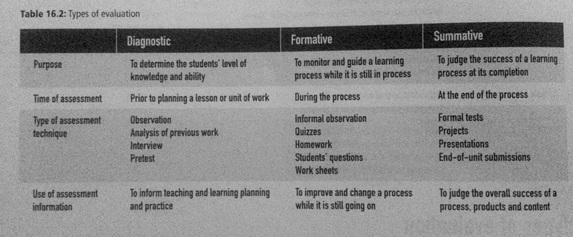Professional Practice
|
5.1 Assess student learning |
Assessment is crucial in education, in that it informs all that we do as teachers. AITSL identifies that the graduate teacher will "demonstrate understanding of assessment strategies, including informal and formal, diagnostic, formative and summative approaches to assess student learning". There are many stakeholders when it comes to assessment practices including school leadership, sectional/subject teachers, classroom teachers, students and parents/carers, and each of these stakeholders finds value in different forms of assessment. "Diagnostic evaluation is carried out to determine the specific needs of the students in the cognitive, affective and psychomotor domains[...] Formative evaluation is when the teacher continuously monitors the teaching and learning process[...] [and] Summative evaluation is basically a summary of the learning experience" (Whitton et. el., 2010, p. 191-2). This type of assessment is achieved through observation, determining prior-knowledge and skills through pre-testing, analysis of work samples, and interviewing students. Assessment may be norm-reference, criterion-reference or self-referenced.
Whitton et. al. (2010) remark that "for successful teaching and learning there needs to be a link between the teaching and assessment" (p. 195). Successful assessment must be authentic to the students and to the learning process. Pre-assessment can also be used to establish students' prior knowledge, interests and readiness for learning tasks. It also plays a pivotal role in informing teaching, and in adapting lessons, units, curriculum and further assessments for the successful outcomes of the student. Black and Wiliam (1998) make the following statement:
|
Teachers need to know about their pupils' progress and difficulties with learning so that they can adapt their own work to meet pupils' needs -- needs that are often unpredictable and that vary from one pupil to another. Teachers can find out what they need to know in a variety of ways, including observation and discussion in the classroom and the reading of pupils' written work. (p. 140)
|
Professional Experience Report ExcerptThroughout my professional experience, I assessed student learning in a number of ways, including both formative and summative assessment, as well as pre-assessment. This assessment informed my teaching practice and directed further planning. This is indicated by mentor's comments in my final report. Skills used for assessment included observations, anecdotal records, analysing work samples, summative assessment tasks, and recording and sharing assessment results for reporting.
|
Sample Assessment RubricRubrics are one example of the types of assessment tools that can be used in the classroom. The following is a sample rubric for a Year 2 Mathematics topic on money. Rubrics are a criterion-referenced assessment, and provide specific levels of achievement against intended outcomes. This rubric was used as a tool for formative and summative assessment throughout the unit to guide teaching and assess for conceptual understanding.
|
Your browser does not support viewing this document. Click here to download the document.
Scroll through document or select icon in bottom right corner to view in full screen.
|
Sample Anecdotal Record ChecklistThroughout my professional experience I used checklists and anecdotal records of observations to informally assess students, to inform future teaching, and to ascertain whether students were meeting the prescribed outcomes. The following checklist is an example of a record that was used during a literature study unit. Key questions were used and cross-referenced against work samples and verbal communication with students.
|
Your browser does not support viewing this document. Click here to download the document.
Scroll through document or select icon in bottom right corner to view in full screen.
|
References
Black, P., & Wiliam, D. (1998). Inside the black box: raising standards through classroom assessment. Phi Delta Kappan, 80(2), 139-155.
Whitton, D., Barker, K., Nosworth, M., Sinclair, C., & Nanlohym P. (2010). Learning for teaching, teaching for learning. South Melbourne: Cengage Learning.
Black, P., & Wiliam, D. (1998). Inside the black box: raising standards through classroom assessment. Phi Delta Kappan, 80(2), 139-155.
Whitton, D., Barker, K., Nosworth, M., Sinclair, C., & Nanlohym P. (2010). Learning for teaching, teaching for learning. South Melbourne: Cengage Learning.

This work by Amelia Smart is licensed under a Creative Commons Attribution-NonCommercial-NoDerivatives 4.0 International License.


